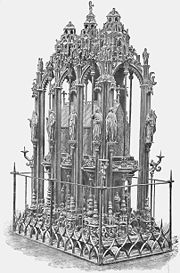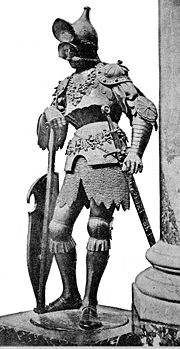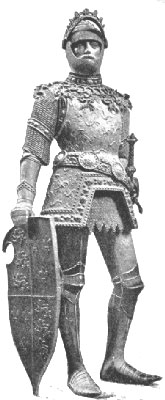
Peter Vischer the Elder
Encyclopedia
Peter Vischer the Elder (c. 1455 – January 7, 1529) was a German sculptor, the son of Hermann Vischer, and the most famous member of the noted Vischer Family of Nuremberg
.
 Peter was born in Nuremberg, where he also died. He became "master" in 1489, and in 1494 was summoned by Philip, Elector Palatine
Peter was born in Nuremberg, where he also died. He became "master" in 1489, and in 1494 was summoned by Philip, Elector Palatine
to Heidelberg
. He soon returned, however, to Nuremberg, where he worked with the help of his five sons, Hermann, Peter, Hans, Jakob and Paul. His works are: the tomb of Bishop Johannes IV., in the Breslau cathedral (1496); the tomb of Archbishop Ernest, in Magdeburg
cathedral (1497); the shrine of Saint Sebald in the Sebalduskirche at Nuremberg, between 1508 and 1519; a large grille ordered by the Fugger
brothers in Augsburg (lost); a relief of the "Crowning of the Blessed Virgin" in the Erfurt cathedral (a second example in the Wittenberg
Schlosskirche, 1521); the tombstones for Margareta Tucherin in the Regensburg
cathedral (1521), and for the Eisen family in the Agidienkirche at Nuremberg (1522); the epitaph for the cardinal Albrecht of Brandenburg
in the collegiate church at Aschaffenburg
(1525); the epitaph of the duchess Helene of Mecklenburg
in the cathedral at Schwerin
. Besides these works there are a number of others ascribed to Peter the Elder with less certainty. In technique few bronze sculptors have ever equalled him, but his designs are marred by an excess of mannered realism and a too exuberant fancy. His chief early work, the tomb of Archbishop Ernest in Magdeburg
cathedral (1495), is surrounded with fine statuettes of the Apostles under semi-Gothic canopies; it is purer in style than the magnificent shrine of St Sebald, a tall canopied bronze structure, crowded with reliefs and statuettes in the most lavish way in the St. Sebaldus Church
.

 The general form of the shrine is Gothic, 1 but the details are those of the 16th-century Italian Renaissance treated 1 This great work is really a canopied pedestal to support and enclose the shrine, not the shrine itself, which is a work of the 14th century, having the gabled form commonly used in the Middle Ages for metal reliquaries with much freedom and originality. Some of the statuettes of saints attached to the slender columns of the canopy are modeled with much grace and even dignity of form. A small portrait figure of Peter himself, introduced at one end of the base, is a marvel of clever realism: he has represented himself as a stout, bearded man, wearing a large leathern apron and holding some of the tools of his craft.
The general form of the shrine is Gothic, 1 but the details are those of the 16th-century Italian Renaissance treated 1 This great work is really a canopied pedestal to support and enclose the shrine, not the shrine itself, which is a work of the 14th century, having the gabled form commonly used in the Middle Ages for metal reliquaries with much freedom and originality. Some of the statuettes of saints attached to the slender columns of the canopy are modeled with much grace and even dignity of form. A small portrait figure of Peter himself, introduced at one end of the base, is a marvel of clever realism: he has represented himself as a stout, bearded man, wearing a large leathern apron and holding some of the tools of his craft.

This gorgeous shrine is a remarkable example of the uncommercial spirit which animated the artists of that time, and of the evident delight which they took in their work. Dragons, grotesques and little figures of boys, mixed with graceful scroll foliage, crowd every possible part of the canopy and its shafts, designed in the most free and unconventional way and executed with an utter disregard of the time and labor which were lavished on them. The two figures for the tomb of Maximilian I, Holy Roman Emperor
by Peter Vischer (King Arthur
& Theodoric the Great
), at the Hofkirche, Innsbruck
, begun in 1521, are perhaps the most meritorious German work of this class in the 16th century, and show considerable Italian influence. Arthur, and perhaps Theoderic too, was designed by Albrecht Dürer
. Headlam believes that Peter Vischer the Younger is responsible for the Arthur and that Peter Vischer the Elder is responsible for Theoderic.
Peter Vischer the Elder is honored at the Walhalla
, Hall of Fame and Honor which currently honors 191 German speaking individuals of the last 1800 years.
Vischer Family of Nuremberg
Vischer is the name of a family of sculptors active in Nuremberg between 1453 and 1549. The family contributed largely to the masterpieces of German art in the 15th and 16th centuries. Attribution between them can be confusing since they worked together out of the same workshop...
.

Philip, Elector Palatine
Philip the Upright, Elector Palatine of the Rhine was an Elector Palatine of the Rhine from the house of Wittelsbach from 1476 to 1508....
to Heidelberg
Heidelberg
-Early history:Between 600,000 and 200,000 years ago, "Heidelberg Man" died at nearby Mauer. His jaw bone was discovered in 1907; with scientific dating, his remains were determined to be the earliest evidence of human life in Europe. In the 5th century BC, a Celtic fortress of refuge and place of...
. He soon returned, however, to Nuremberg, where he worked with the help of his five sons, Hermann, Peter, Hans, Jakob and Paul. His works are: the tomb of Bishop Johannes IV., in the Breslau cathedral (1496); the tomb of Archbishop Ernest, in Magdeburg
Magdeburg
Magdeburg , is the largest city and the capital city of the Bundesland of Saxony-Anhalt, Germany. Magdeburg is situated on the Elbe River and was one of the most important medieval cities of Europe....
cathedral (1497); the shrine of Saint Sebald in the Sebalduskirche at Nuremberg, between 1508 and 1519; a large grille ordered by the Fugger
Fugger
The Fugger family was a historically prominent group of European bankers, members of the fifteenth and sixteenth-century mercantile patriciate of Augsburg, international mercantile bankers, and venture capitalists like the Welser and the Höchstetter families. This banking family replaced the de'...
brothers in Augsburg (lost); a relief of the "Crowning of the Blessed Virgin" in the Erfurt cathedral (a second example in the Wittenberg
Wittenberg
Wittenberg, officially Lutherstadt Wittenberg, is a city in Germany in the Bundesland Saxony-Anhalt, on the river Elbe. It has a population of about 50,000....
Schlosskirche, 1521); the tombstones for Margareta Tucherin in the Regensburg
Regensburg
Regensburg is a city in Bavaria, Germany, located at the confluence of the Danube and Regen rivers, at the northernmost bend in the Danube. To the east lies the Bavarian Forest. Regensburg is the capital of the Bavarian administrative region Upper Palatinate...
cathedral (1521), and for the Eisen family in the Agidienkirche at Nuremberg (1522); the epitaph for the cardinal Albrecht of Brandenburg
Albert of Mainz
Cardinal Albert of Hohenzollern was Elector and Archbishop of Mainz from 1514 to 1545, and Archbishop of Magdeburg from 1513 to 1545.-Biography:...
in the collegiate church at Aschaffenburg
Aschaffenburg
Aschaffenburg is a city in northwest Bavaria, Germany. The town of Aschaffenburg is not considered part of the district of Aschaffenburg, but is the administrative seat.Aschaffenburg is known as the Tor zum Spessart or "gate to the Spessart"...
(1525); the epitaph of the duchess Helene of Mecklenburg
Mecklenburg
Mecklenburg is a historical region in northern Germany comprising the western and larger part of the federal-state Mecklenburg-Vorpommern...
in the cathedral at Schwerin
Schwerin
Schwerin is the capital and second-largest city of the northern German state of Mecklenburg-Vorpommern. The population, as of end of 2009, was 95,041.-History:...
. Besides these works there are a number of others ascribed to Peter the Elder with less certainty. In technique few bronze sculptors have ever equalled him, but his designs are marred by an excess of mannered realism and a too exuberant fancy. His chief early work, the tomb of Archbishop Ernest in Magdeburg
Magdeburg
Magdeburg , is the largest city and the capital city of the Bundesland of Saxony-Anhalt, Germany. Magdeburg is situated on the Elbe River and was one of the most important medieval cities of Europe....
cathedral (1495), is surrounded with fine statuettes of the Apostles under semi-Gothic canopies; it is purer in style than the magnificent shrine of St Sebald, a tall canopied bronze structure, crowded with reliefs and statuettes in the most lavish way in the St. Sebaldus Church
St. Sebaldus Church
St. Sebaldus Church is a medieval church in Nuremberg, Germany. Along with Frauenkirche and St. Lorenz, it is one of the most important churches of the city, and also one of the oldest. It is located at the Albrecht-Dürer-Platz, in front of the old city hall...
.



This gorgeous shrine is a remarkable example of the uncommercial spirit which animated the artists of that time, and of the evident delight which they took in their work. Dragons, grotesques and little figures of boys, mixed with graceful scroll foliage, crowd every possible part of the canopy and its shafts, designed in the most free and unconventional way and executed with an utter disregard of the time and labor which were lavished on them. The two figures for the tomb of Maximilian I, Holy Roman Emperor
Maximilian I, Holy Roman Emperor
Maximilian I , the son of Frederick III, Holy Roman Emperor and Eleanor of Portugal, was King of the Romans from 1486 and Holy Roman Emperor from 1493 until his death, though he was never in fact crowned by the Pope, the journey to Rome always being too risky...
by Peter Vischer (King Arthur
King Arthur
King Arthur is a legendary British leader of the late 5th and early 6th centuries, who, according to Medieval histories and romances, led the defence of Britain against Saxon invaders in the early 6th century. The details of Arthur's story are mainly composed of folklore and literary invention, and...
& Theodoric the Great
Theodoric the Great
Theodoric the Great was king of the Ostrogoths , ruler of Italy , regent of the Visigoths , and a viceroy of the Eastern Roman Empire...
), at the Hofkirche, Innsbruck
Hofkirche, Innsbruck
The Hofkirche Innsbruck, Austria, is a Gothic church built 1553–1563 by Ferdinand I as a memorial to his grandfather Maximilian I, Holy Roman Emperor , whose cenotaph within boasts a remarkable collection of German Renaissance sculpture...
, begun in 1521, are perhaps the most meritorious German work of this class in the 16th century, and show considerable Italian influence. Arthur, and perhaps Theoderic too, was designed by Albrecht Dürer
Albrecht Dürer
Albrecht Dürer was a German painter, printmaker, engraver, mathematician, and theorist from Nuremberg. His prints established his reputation across Europe when he was still in his twenties, and he has been conventionally regarded as the greatest artist of the Northern Renaissance ever since...
. Headlam believes that Peter Vischer the Younger is responsible for the Arthur and that Peter Vischer the Elder is responsible for Theoderic.
Peter Vischer the Elder is honored at the Walhalla
Walhalla temple
The Walhalla temple is a hall of fame that honors laudable and distinguished Germans, famous personalities in German history — politicians, sovereigns, scientists and artists of the German tongue". The hall is housed in a neo-classical building above the Danube River, east of Regensburg, in...
, Hall of Fame and Honor which currently honors 191 German speaking individuals of the last 1800 years.

